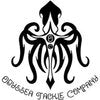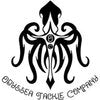Frequently Asked Questions
What is a Tuna Spreader Bar?
There are several variation of Spreader Bars on the market today. Thirty plus years ago the first bars were developed on the East Coast for giant bluefin. The basic idea was to create a platform to attach several artificial teasers to represent a bait ball. The original Bars were heavy and dug into the water. Some of them had hooks on every tailing teaser, which did not last long. It took time to make the adjustments necessary to become what they are today. One of the pioneers of new fishing methods was Captain Fred Archer. Significant progress was made with Captain Archer's "Super Bars". Developed by "OG" Captain Archer, these flexible spreader bars were made with plastic composite, were light weight, and deadly. They caught plenty of Yellowfin and Dorado, and even worked great for albacore too. The only issue was that they simply didn't last very long. Fast forward to 2022 and the spreader bar has come a very long way. With the utilization of lightweight titanium, spreader bars today are deadly and used all over the world with many different variations.
How do I fish a Spreader Bar for tuna in Southern California Waters?
Length and spread vary greatly. We find that a bit further back than usual works best. Some fisherman have had great success way back up to 300 yards off the stern! Others have also been successful with a traditional spread closer to the transom just outside the wake. We find that setting the bars back a bit further is most successful for finicky Bluefin. A good place to start is a good 25 yards behind the propwash here on the west coast. With outriggers a "W" pattern is a good place to start. For smaller skiffs without outriggers, it is possible to drag several lines but just like to drag 2 on the corners with a daisy long down the center. Find what works best for your boat.
We add floats in our bulb squid so that your bar sits up high when trolled, avoids digging, and floats when you are bringing in your lines. Imagine winding in a 48-inch spreader bar from 300 yards that sinks, no fun. Bright colors on bright days and darker on overcast days works best but every day is different. It is important to use a size larger “Chase Bait” than the size squid on the bar. For example, a 9-inch squid bar should use an 11 inch or larger “Chase Bait”. The Chase bait is attached by a 450lb Coastlock Snap and is weighted in the head to sit just below the surface and mimic a predatory fish chasing the school. This “Chase Bait” is the only one with a hook and is what almost always gets bit. If you drag the bar through a foamer of 100 plus pound tuna, it will probably not come out in one piece. Try to keep that in mind as those large fish will tear it to pieces.
When setting out your lures, its best to put the boat in gear when you set in the water to make sure the bar is running true. and not tangled. Utilize 50 class Tackle (size 50 or at least 30 reels) for the larger 36- and 48-inch bars. The small Micro Bars can be dragged using smaller tackle, but its always best to be prepared for that monster fish.
If it late in the season and you are fishing the school sized yellowfin and Dorado much closer to the boat, lighter tackle may be fine. We have a blast using the micro "Skiff Special" bars down in Baja for Dorado and Yellowfin. For the Bluefin fishing, we stick with larger tackle because of the line capacity (distance trolling) and ease when hooking big fish. It is also much easier to crank in your fish with the rod in the holder. These bars put up a lot of drag and the fish is also fighting the drag. Something to keep in mind.
How fast do I run when using Spreader Bars?
Find the speed that works best for the conditions on the particular day, usually 6-9 knots works best here on the West Coast. Sometimes we like to troll em fast and the lighter skiff special, 18 and 36 classic bars can be trolled up to 12 knots and run with a Madmac. You need flat conditions to do this. You want the bar to put up some water. This is what attracts predators.
What size Bar and what size Squid should I choose?
Match The Hatch. This means matching the lures to the bait in the water that the fish are feeding on. We find that the upper spectrum of size attracts larger fish. Some days they are eating tiny bait and wont bite anything, other days the 30lb Tuna will eat a 13-inch squid no problem. It’s good to have a couple different size bars but try to match the bait in the water to the size teasers. This is why its good to have one of the micro "Skiff Special" bars handy. We rig them to stand up to big fish.
A good combination would be to have one of each bar; small, medium, and large. Our “Skiff Special” bars, which is a 24-inch bar with 3.5-inch micro squid. Despite being a smaller bar, this is rigged for big fish and can handle large tuna. Next, a 36-inch bar with 9-inch squid, and a 36–48-inch bar with 11- or 13-inch squid. Add 3-4 different color chase baits and you have a deadly combination. All of our bars have an interchangeable chase bait system so you can switch out colors . Add a couple of Daisy Chains and you will have everything you need. If you were to pick one bar to start, the 36-inch bar with 9 or 11-inch squid would be a good choice.
Why do you use Titanium Bars instead of steel?
Titanium flexes and is much lighter than steel. It is important to have the bar flex and bounce the baits forward while in the water. You do not want a stiff heavy bar. While having a light and flexible bar is important in getting bites, this also means that the bar will bend over time. The bar will flex over time, and this is normal. I am happy to re rig and replace the bar for a reasonable fee, so you don’t have to buy an entire new one. These things get torn up by big tuna. We offer this option because we construct them here locally, not in China like some of the larger companies.
Do you make Side Tracker Bars?
Yes we do. We have recently built a side tracker that has a more solid rudder. Not the thin plastic that breaks like other companies. Our "Super Trackers" are interchangeable from port to starboard. You asked and we delivered. If they are not already up on the site they will be soon.
How do I use “Odyssea Super Trackers” side tracking bar?
Our new wide trackers offer the ability to widen the trolling spread without the need for outriggers. The center lead bird on the spreader bar is equipped with a heavy duty rudder that causes the bar to troll at an angle to widen the spread up to 75 feet on each side (port/starboard). The further back you place the bar, the wider it tracks in the spread. This allows you to troll multiple bars without the risk of tangling. Side tracking bars tend to do better on calmer days. Odyssea Super Tracker bars are adjustable allowing the angler to troll the bar to port, starboard, or even straight. The directions to do so are below.
To Change Directions from Port/Starboard vice versa
- With correct size Phillips head screw driver carefully remove the screw on bottom of rudder, making sure not to strip the screw head.
- Simply pull rudder off and reposition in opposite direction.
- Insert screw back into rudder securing it tightly.
- The bar has 5 drops (lines) with teasers. You will find one with a 2oz sinker attached. Each drop is attached to the bar by a heavy duty split ring. Simply remove the drop with the sinker and switch it with the opposite side. The sinker prevents the bar from flipping as the side-tracking rudder causes one side of the bar to dip as water hits it at an angle. You need to switch the drop with the sinker everytime you switch the rudder. The whole process should take just a few minutes.
To Make the Bar a Straight tracking Bar
- Complete the above steps but remove the rudder completely (Be sure to save the screw in a safe place)
- Remove the drop with the sinker and replace with the extra drop without sinker that came with your order (If purchased).
- Now you are ready to troll your bar straight.
What colors work the best?
All of the colors we have catch fish. Some of our favorites are Tomato, Pink/Purple, Natural, Green/Black, Purple/black, Brown w/ Aqua scales, Green Mackerel, and Blue Mackerel. The Lime Glow, Hot Pink, Red/Back, and Natural are all great color chase bait colors. Every day is different but having a few different options is a smart move.
Do you use Fluorocarbon for your Chase Baits?
We use 200-300lb Fluorocarbon depending on the size of the Bar. All of our bars use 300lb Aftco Saiko Pro Fluorocarbon with the exception of our 24-inch Skiff Special, which uses 200lb. We understand the bite is reactionary and flourocarbon is likely not needed. We feel that any benefit is a good benefit so we use it anyways. Its tougher and chafe resistant. We have hooked Wahoo in Baja on the bars as well and were happy we had the flourocarbon. If you would like mono please let us know and we will happily rig your baits with Izorline.
Instructions for the Care of your Spreader Bars and Daisy Chains
1.Do not store your spreader bar in a hot area for long periods. This will break down the teasers and components.
2. Make sure after each use to rinse your bar with fresh water and let hang dry before storing in your bag.
3. If you have room to hang your spreader bar in a cool, dry, dark place, this is best.
4. A light silicone spray or some Salt Away on the components and teasers helps to prolong the life of your spreader bar.
How long does it take to get my order?
We construct every Spreader Bar and Daisy Chain to order. Give us 5 business days to ship your order. Most of the time it will be shipped sooner. If you have any special requests or need your bar sooner, please let us know and we can make it happen.
Please let me know if you have any questions or concerns. We appreciate your support, and we are confident you will find that we provide a well-made product at a very reasonable price.
Tight Lines
Ethan @ Odyssea Tackle Company




